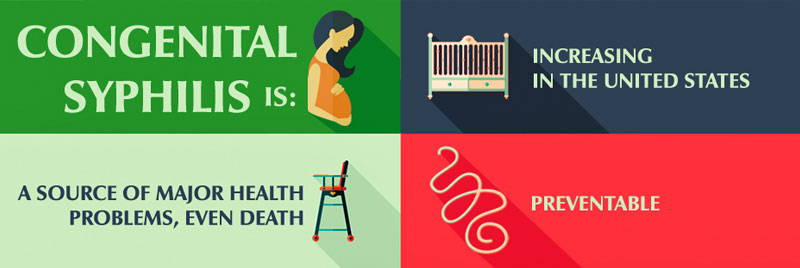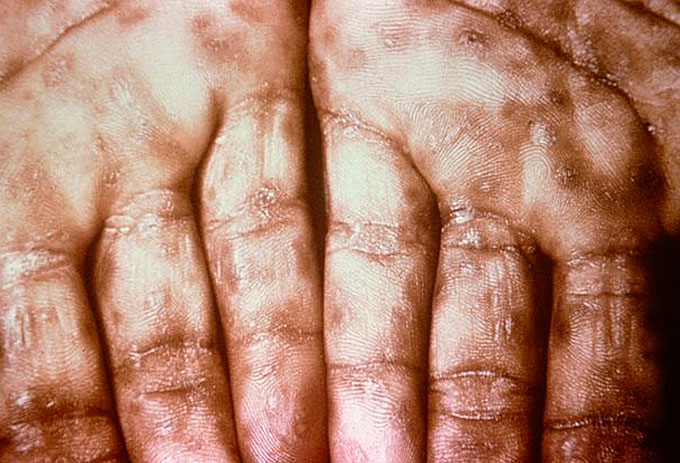
Today, CDC released the Sexually Transmitted Disease (STD) Surveillance Report, 2018.
STDs reached an all-time high in 2018, marking the fifth consecutive year of increases for chlamydia, gonorrhea, and syphilis.
The most alarming threat: newborn deaths from syphilis.
There was a startling 22 percent increase in newborn deaths from 77 in 2017 to 94 in 2018.
This goes beyond data and surveillance, beyond numbers and calculations – we lost 94 lives before they even began to an entirely preventable infection.
CDC’s “State of the Union” on sexually transmitted diseases (STDs) in the United States stresses that we must stop syphilis – too many babies are needlessly dying
Coinciding with those deaths, we are seeing a continued increase in congenital syphilis, or syphilis passed from a mother to her baby during pregnancy.
In addition to newborn death, congenital syphilis can result in miscarriage or severe lifelong physical and neurological problems for the child.
(Learn More. Congenital syphilis rates double nationwide, Spokane County at particular risk. Courtesy of 4 News Now and YouTube. Posted on Sep 26, 2018.)
There were a total of 1,306 congenital syphilis cases reported in 2018; the most since 1995.
The case rate spiked 40 percent in one year alone and 185 percent since 2014.
We face a struggle that is at once national, but also highly concentrated.
Forty-one states and Washington D.C. reported at least one case of congenital syphilis.
Yet five states were disproportionately burdened with the majority (70%) of cases.
Every single instance of congenital syphilis is one too many when we have the tools to prevent it.
(It’s been referred to as “great pox,” “great crippler” and “loues” (pronounced lou-ease) along with a number of names and references over the centuries. Syphilis has long been a global health issue affecting millions of men, women and children. After decades of decline due to treatment with penicillin, infection rates are on the rise. A recent report by the Centers for Disease Control and Prevention shows steady increases especially among women and their babies, and men who have sex with men. Courtesy of Mayo Clinic and YouTube. Posted on Oct 29, 2018.)
Our situation is severe.
However, we can stem the rising tide of STDs by working together – CDC, decision makers and community leaders, health departments, healthcare systems including healthcare providers, and researchers.
We have an urgent to-do list:
1.) First, we must address the rising rate of syphilis among women.
-
Data show the increase in congenital syphilis goes hand-in-hand with increasing syphilis rates among women of reproductive age.
-
One clear solution is to intensify our efforts to find women with syphilis and swiftly connect them to care and immediate treatment.
-
Doing so keeps them healthy and, for those who become pregnant, it keeps their babies healthy, too.
2.) The second part of the equation is fairly straightforward: Protect moms = Protect babies.
-
To prevent congenital syphilis, it is critical to increase prenatal syphilis testing and provide immediate treatment.
-
CDC recommends healthcare providers test all pregnant women at their first prenatal visit.
-
Women who are more vulnerable to acquiring syphilis later in pregnancy should be tested again at 28 weeks and at delivery.
-
Outside of the exam room, we must topple the barriers to prenatal care that hinder our ability to reach, quickly test, and treat pregnant women.
-
We can all – providers and public health professionals alike – consider who patients and clients are, the circumstances of their environment, and how those circumstances may affect their risk.
-
This kind of thinking is essential to breaking an endless cycle that endangers the health and wellbeing of too many.

2.) And third, while we focus on congenital syphilis, we must also uphold basic STD prevention and control to halt the rising increases of other STDs.
-
State and local health departments should strengthen the local public health infrastructure and ensure resources are directed appropriately.
-
In addition, health care providers should make screening and timely treatment a standard part of medical care.
In spite of all of these challenges, CDC remains committed to keeping Americans healthy through STD prevention.
As anyone who knows me knows, I have dedicated my entire career to this important work—and continue proudly standing at your side to take on these diseases.
Together, we can turn the tide to protect the people we diligently serve day in and day out. Thank you for your unwavering dedication to STD prevention.
Sincerely, Gail Bolan, M.D.
Three STDs reach all-time highs in the US, new CDC report says

October 8, 2019 – In Breaking News – CNN
Health officials are raising alarm about a rise in STDs across the United States.
For the fifth consecutive year, combined cases of gonorrhea, chlamydia and syphilis have risen in the United States, according to a Sexually Transmitted Disease Surveillance Report from the US Centers for Disease Control and Prevention published on Tuesday.
“Combined they total 2.4 million infections that were diagnosed and reported just in last year alone,” said Elizabeth Torrone, a CDC epidemiologist who worked on the new report, adding that the combined number marks “the most cases” ever recorded since monitoring began in the United States.
A rise in the prevalence and incidence of STDs can come with serious public health consequences and concerns, including infertility, drug-resistant gonorrhea and congenital syphilis, which can cause infant death.
(Sexually transmitted diseases are at an all-time high. Data from the CDC shows STDs have been rising for the past four years. Courtesy of KVUE and YouTube. Posted on Jan 15, 2019.)
“Yet not that long ago, gonorrhea rates were at historic lows, syphilis was close to elimination, and we were able to point to advances in STD prevention,” Dr. Gail Bolan, director of the CDC’s Division of STD Prevention, wrote in the new report’s foreword.

“That progress has since unraveled. The number of reported syphilis cases is climbing after being largely on the decline since 1941, and gonorrhea rates are now increasing.
“Many young women continue to have undiagnosed chlamydial infections, putting them at risk for infertility.”
Possible factors driving this rise in STD cases, which vary depending on where you live, include a surge in people getting tested and cases being diagnosed and reported.
There’s also a decline in people using condoms.
The new report found that rates of reported cases tended to be highest among adolescents and young adults.
(Researchers say STD rates are at a record high. Courtesy of WSLS 10 and YouTube. Posted on Aug 29, 2018.)
The new CDC report calls for federal, state and local agencies to employ strategies that reduce STD incidence and help to improve sexual, reproductive, maternal and infant health.

“STDs cause a significant burden to the health care system — both in terms of direct medical costs for treating STDs as well as the personal cost for people who have an STD,” Torrone said.
“As the STD epidemic continues to grow in the United States, the direct medical costs and the quality of life lost will just increase as well.”
Continue reading… Three STDs reach all-time highs in the US, new CDC report says
AST strives to meet a 3 STAR trustworthiness rating, based on the following criteria:
- Provides named sources
- Reported by more than one notable outlet
- Includes supporting video, direct statements, or photos

















